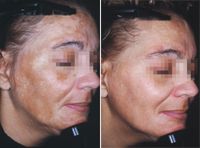- Acne
- Actinic Keratosis
- Aesthetics
- Alopecia
- Atopic Dermatitis
- Buy-and-Bill
- COVID-19
- Case-Based Roundtable
- Chronic Hand Eczema
- Chronic Spontaneous Urticaria
- Drug Watch
- Eczema
- General Dermatology
- Hidradenitis Suppurativa
- Melasma
- NP and PA
- Pediatric Dermatology
- Pigmentary Disorders
- Practice Management
- Precision Medicine and Biologics
- Prurigo Nodularis
- Psoriasis
- Psoriatic Arthritis
- Rare Disease
- Rosacea
- Skin Cancer
- Vitiligo
- Wound Care
Article
Depigmenting agents for melasma: Prescription, nonprescription options exist
Dermatologists commonly turn to a variety of depigmenting agents and therapies for the treatment of melasma and post-inflammatory hyperpigmentation after acne, or traumatic scars and burns, according to Helen M. Torok, M.D., Medical Director, Trillium Creek Dermatology & Surgery, in Medina, Ohio.

Key Points

"The two depigmenting agent categories are the phenolic agents or natural agents," says Dr. Torok, vice president, American Society of Cosmetic Dermatology & Aesthetic Surgery (ASCDAS).
Hydroquinone, a common ingredient in over-the-counter bleaching agents and prescription products, is the gold standard which has been used for the last 50 years.
If that is banned, dermatologists will have to turn to other agents or the natural depigmenting agents.
Another phenolic agent that is used less frequently is the permanent depigmenting agent, monobenzyl ether of hydroquinone. "This agent, which completely removes the pigment permanently, is used in patients who have severe vitiligo," she says.

Topical tretinoin, such as Retin A (Ortho) or retinoids, is also used, because it allows the depigmenting agents to work faster.
Natural treatments
Prescription treatments take about four to six months to work, natural agents may take longer. However, natural depigmenting agents won't have any side effects or absorption issues, which is especially important if the patient is pregnant.
Azelaic acid, a naturally occurring hydroxyl carboxylic acid (not a phenol), can also be used. "The products Finacea and Azelex are azelaic acids. It is a little slower in depigmenting, but safer," she says.
Lemon juice, grapefruit juice, papaya or kiwi juice can be used as natural depigmenting agents. "All you have to do is squeeze juice out of any of these fruits and apply as a compress for 20 minutes to the site every day, and that is a slower acting, natural depigmenting agent," she says.
While using these products, patients never want to go out in the sun, because they will get phytophotodermatitis. "If a person has the resin from lemons or limes on the skin and then are exposed to the sun, there is a phototoxic reaction," she says.
Dermatologists also can recommend the natural agent licorice (topical glabridin). "Another depigmenting agent is called Arbutin. It is similar to hydroquinone, but it is from plants.," she says.
Kojic acid is a commonly used over-the-counter bleaching agent. This is a naturally occurring hydrophilic fungal derivative evolved from certain species of Aspergillus.
Hydroquinone has been banned in England and Japan for fear of ochronosis and hyperpigmentation. For example, now only kojic acid and other natural products are used in Japan.
Accelerated treatment
Today, many patients desire quick, if not immediate, results. To accelerate the depigmenting process, dermatologists can add chemical peels to the regimen.
In addition, intense-pulsed light (IPL) can be added to the mix.
"However, you have to be careful, because intense-pulsed light can sometimes darken and aggravate the melasma," she says.
The treatment of choice is the fractional IPL, which is specifically indicated for melasma and pigmentary disorders. It can be used in conjunction with the other therapies as well.
"As soon as you have healed from the peels and lasers, you have to resume the combination treatments of hydroquinone or Triluma or some of the natural depigmenting remedies; otherwise, there is a risk of recurrence.
"Sunblock also is critical. Use a UVA and a UVB broad-spectrum to prevent recurrence," Dr. Torok says.
Newsletter
Like what you’re reading? Subscribe to Dermatology Times for weekly updates on therapies, innovations, and real-world practice tips.











